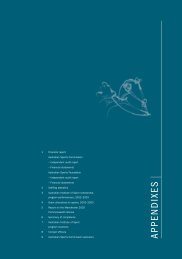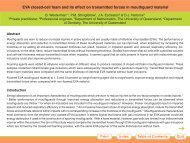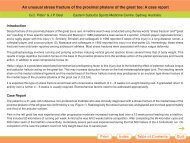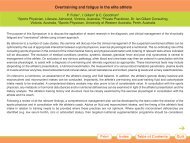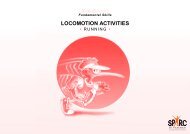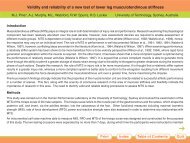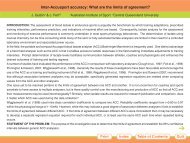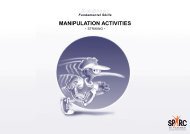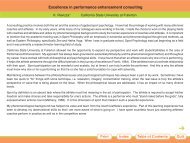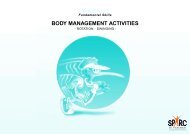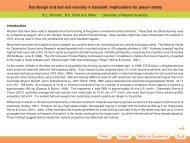Celecoxib for sporting injuries - Australian Sports Commission
Celecoxib for sporting injuries - Australian Sports Commission
Celecoxib for sporting injuries - Australian Sports Commission
Create successful ePaper yourself
Turn your PDF publications into a flip-book with our unique Google optimized e-Paper software.
Introduction<br />
<strong>Celecoxib</strong> <strong>for</strong> <strong>sporting</strong> <strong>injuries</strong>: Tolerability and side effects<br />
A.B. Johnston* Western Australia<br />
Non-steroidal anti-inflammatory drugs (NSAIDs) are widely used in the treatment of <strong>sporting</strong> <strong>injuries</strong>. Inflammation occurs at the site of injury.<br />
A local soft tissue injury causes the release of arachidonic acid from cell walls. Arachidonic acid is converted by a number of enzymes, in<br />
particular cyclo-oxygenase(COX), to prostaglandins, thromboxane and prostacyclins. NSAIDs have been shown to interfere with the conversion<br />
of arachidonic acid to prostaglandin by inhibiting the action of COX. NSAIDs may also have other effects on the inflammatory response.<br />
Although NSAIDs are effective <strong>for</strong> the relief of pain and inflammation, their use is tempered by the development of side effects, primarily<br />
gastrointestinal.<br />
Cyclo-oxygenase exists as at least two isoenzymes, COX-1 and COX-2. COX-1, a wide-ranging essential enzyme, produces prostaglandins<br />
involved in cytoprotective and regulatory functions in gastrointestinal mucosa, platelets, and renal cells; gastric prostaglandins are derived<br />
almost exclusively from COX-1. COX-2, predominantly a cytokine-induced enzyme, produces prostaglandins that mediate pain and inflammation.<br />
All NSAIDs inhibit COX-1 and COX-2, each to varying degrees. The therapeutic effects of NSAIDs are achieved by COX-2 inhibition, but many<br />
of the toxic effects, most commonly gastroduodenal injury, result from COX-1 inhibition. <strong>Celecoxib</strong> was designed to specifically inhibit COX-2.<br />
Clinical trials have demonstrated that celecoxib is as effective in ameliorating signs and symptoms of osteoarthritis and rheumatoid arthritis<br />
as conventional NSAIDs, and as effective as aspirin in reducing pain following dental extraction. Controlled trials have also shown that the<br />
incidence of gastroduodenal ulcers and erosions are significantly lower with celecoxib than with conventional NSAIDs.<br />
There are no published data on the use of celecoxib <strong>for</strong> acute <strong>sporting</strong> <strong>injuries</strong>. With conventional NSAIDs, there is no convincing evidence<br />
as to their effectiveness in the treatment of acute soft tissue <strong>injuries</strong>. Numerous studies have been done but most lacked a placebo group and<br />
compared the effectiveness on one NSAID with another.<br />
At a local Perth football club, short courses of NSAIDs are routinely used in the treatment of acute soft tissue <strong>injuries</strong>. Side effects, usually<br />
gastrointestinal, do occur. The incidence of peptic ulceration with the short term use of NSAIDs is rare in the athletic population. Players are<br />
highly motivated to recover from <strong>injuries</strong> and sometimes this leads them to take high doses of NSAIDs. An effective NSAID with a better safety<br />
profile would be welcomed. This study will look at the tolerability, side effects and efficacy of celecoxib in the treatment of acute <strong>sporting</strong><br />
<strong>injuries</strong>.<br />
Print<br />
Index<br />
Table of Contents<br />
Quit
Methods<br />
<strong>Celecoxib</strong> <strong>for</strong> <strong>sporting</strong> <strong>injuries</strong>: Tolerability and side effects<br />
A.B. Johnston* Western Australia<br />
Study population: Males playing semi-professional <strong>Australian</strong> Rules football at a local Perth football club. Aged between 18 and 30 years.<br />
Those sustaining a soft tissues injury from their sport, and requiring treatment.<br />
Exclusions: Aged under 18 or over 30 years. Aspirin sensitive asthma. Allergy to aspirin or NSAIDs. Allergy to sulfur. Those requiring an<br />
injection of corticosteroid or anaesthetic during the course of the study. Those on continuous NSAIDs or corticosteroid medication. Any player<br />
who has been included in the study and has a further injury, will also be excluded.<br />
Treatment: Players injured during competition or training are assessed by the club doctor. If an acute soft tissue injury that would benefit from<br />
an NSAID, player invited to trial celecoxib. Medication to be started within 24 hours of injury. In<strong>for</strong>med consent given. Player is given a three<br />
day supply of celecoxib with instructions to attend medical staff <strong>for</strong> review. At the three day check, if the injury has resolved, celecoxib is<br />
stopped. Otherwise a further three days supply of celecoxib is given. After 6 days, the player is reviewed again by the club doctor. The club<br />
nurse then assesses tolerability, side effects, and efficacy of treatment. Through direct questioning, the nurse asks the player about any side<br />
effects. Pain relief is assessed on a visual scale of 0 to 5. The nurse asks players if any tablets are left, to check compliance.<br />
There was no randomisation of players into the study. No placebo and no rescue analgesic medication was offered. Although celecoxib is<br />
usually taken twice daily, to aid compliance a daily dose of 400mg once a day was used.<br />
Results<br />
Forty one players completed the study. One player with mild asthma chose not to enter the study as he was concerned about asprin sensitive<br />
asthma. (He had taken ibuprofen the previous year with no problem). Another player was excluded when his injury to the <strong>for</strong>earm turned out<br />
to be a fracture.<br />
The average age of the players was 21 years, the average weight was 80 kg. The lower limb was the commonest site of injury (68%), followed<br />
by the upperlimb (15%) and trunk (17%). The type of injury was muscle or tendon in 23 (56%) cases, and joint in 18 (44%) cases. An<br />
aggravation of a previous injury was seen in 7 (17%) players, with 34 (83%) sustaining a new injury. No serious <strong>injuries</strong> requiring surgery were<br />
recorded.<br />
Print<br />
Index<br />
Table of Contents<br />
Quit
<strong>Celecoxib</strong> <strong>for</strong> <strong>sporting</strong> <strong>injuries</strong>: Tolerability and side effects<br />
A.B. Johnston* Western Australia<br />
Thirty nine players (95%) completed the course of celecoxib, two players stopped after 3 days due to side effects. Diarrhoea occurred in one<br />
(2.4%), and an upper respiratory tract infection in another (2.4%). One player who couldn’t tolerate conventional NSAIDs due to dyspepsia,<br />
had no side effects from six days of celecoxib.<br />
Sixteen players (34%) received a three day course of celecoxib, 25 (61%) having a six day course. For pain relief, 30 (73%) players rated<br />
celecoxib as providing good, or very good cover; with 3 (7.3%) players stating they got little or no pain relief. Seven players (17%) stated the<br />
pain relief lasted <strong>for</strong> 24 hours or more, 34 (83%) having pain relief that didn’t last 24 hours.<br />
Discussion<br />
In this study, fit young adult males were offered celecoxib as part of their injury treatment. There were highly motivated to return to match<br />
fitness. Enthusiastic medical staff followed them up. Leading questions were asked about their response to treatment. There was no<br />
randomisation of players into the celecoxib study. There was no placebo group. Players play football because they love playing. If they miss<br />
a game they also miss out on match payments. Discussions with treatment staff and players indicated that if a placebo was offered to the<br />
player, this could potentially risk them missing a game needlessly, and would be rejected outright by the player. No rescue analgesic medication<br />
was offered to the players. The numbers in this study is small, and the number of adverse effects was low. The incidence of side effects from<br />
a short course of celecoxib was diarrhoea in 2.4%, and upper respiratory tract infection 2.4%. This compares favourably with published studies<br />
of side effects of celecoxib: diarrhoea 5%, upper respiratory infection 7%.<br />
Although celecoxib appeared to give good to very good pain relief in 73% of players, <strong>for</strong> the above reasons this can’t be scientifically proven.<br />
It might only be as effective as paracetamol. More studies need to be done.<br />
For these players who self medicate with super high doses of NSAIDs in the belief they will recover faster, celecoxib would have a place in<br />
reducing the risk of gastroduodenal injury.<br />
It is the intention of the author to increase the sample size of the study to 50, reanalyse the results, and then approach a pharmaceutical<br />
company to determine their interest in sponsoring a large scientific study into celecoxib and its benefits <strong>for</strong> acute <strong>sporting</strong> <strong>injuries</strong>.<br />
Print<br />
Index<br />
Table of Contents<br />
Quit
Conclusion<br />
<strong>Celecoxib</strong> <strong>for</strong> <strong>sporting</strong> <strong>injuries</strong>: Tolerability and side effects<br />
A.B. Johnston* Western Australia<br />
Finding the best and safest treatment <strong>for</strong> <strong>sporting</strong> <strong>injuries</strong> is important. <strong>Celecoxib</strong> appears to help relieve pain, and is well tolerated. Randomised<br />
placebo controlled, scientific studies are needed to determine the place of NSAIDs in treating <strong>sporting</strong> <strong>injuries</strong>.<br />
References<br />
Bruckner, Khan. Clinical sports medicine. McGraw-Hill, 1993; 107<br />
Almekinders LC. Anti-inflammatory treatment of muscular <strong>injuries</strong> in sport. An update of recent studies. <strong>Sports</strong> Med 1999; 28(6): 383-8.<br />
Hertel J. The role of nonsteroidal anti-inflammatory drugs in the treatment of acute soft tissue <strong>injuries</strong>.<br />
J Athletic Training 1997; 32(4): 350-358.<br />
Smyth M. After an injury, what next? Aust Fam Physician 1999; 28: 555-560<br />
Geis GS. Update on clinical developments with celecoxib, a new specific COX-2 inhibitor: what can we expect? Scand J Rheumatol 1999; 28<br />
(Suppl 109): 31-7.<br />
Bensen WG; Fiechtner JJ: McMillen JI, et al. Treatment of osteoarthritis with celecoxib, a cyclooxygenase-2 inhibitor: A randomised controlled<br />
trial. Mayo Clin proc 1999;74: 1095-1105<br />
Hawkey CJ. Cox-2 inhibitors. Lancet 1999; 353:307-314<br />
Brooks PM, Day RO. Cox-2 inhibitors. Med J Aust. 2000; 173: 433-436<br />
Print<br />
Index<br />
Table of Contents<br />
Quit
<strong>Celecoxib</strong> <strong>for</strong> <strong>sporting</strong> <strong>injuries</strong>: Tolerability and side effects<br />
A.B. Johnston*<br />
Western Australia<br />
INTRODUCTION: Non-steroidal anti-inflammatory drugs (NSAIDs) are widely used in the treatment of <strong>sporting</strong> <strong>injuries</strong>. Inflammation<br />
occurs at the site of injury. A local soft tissue injury causes the release of arachidonic acid from cell walls. Arachidonic acid is converted by<br />
a number of enzymes, in particular cyclo-oxygenase(COX), to prostaglandins, thromboxane and prostacyclins. NSAIDs have been<br />
shown to interfere with the conversion of arachidonic acid to prostaglandin by inhibiting the action of COX. NSAIDs may also have other<br />
effects on the inflammatory response. Although NSAIDs are effective <strong>for</strong> the relief of pain and inflammation, their use is tempered by the<br />
development of side effects, primarily gastrointestinal.<br />
Cyclo-oxygenase exists as at least two isoenzymes, COX-1 and COX-2. COX-1, a wide-ranging essential enzyme, produces<br />
prostaglandins involved in cytoprotective and regulatory functions in gastrointestinal mucosa, platelets, and renal cells; gastric<br />
prostaglandins are derived almost exclusively from COX-1. COX-2, predominantly a cytokine-induced enzyme, produces prostaglandins<br />
that mediate pain and inflammation.<br />
All NSAIDs inhibit COX-1 and COX-2, each to varying degrees. The therapeutic effects of NSAIDs are achieved by COX-2<br />
inhibition, but many of the toxic effects, most commonly gastroduodenal injury, result from COX-1 inhibition. <strong>Celecoxib</strong> was designed to<br />
specifically inhibit COX-2. Clinical trials have demonstrated that celecoxib is as effective in ameliorating signs and symptoms of<br />
osteoarthritis and rheumatoid arthritis as conventional NSAIDs, and as effective as aspirin in reducing pain following dental extraction.<br />
Controlled trials have also shown that the incidence of gastroduodenal ulcers and erosions are significantly lower with celecoxib than with<br />
conventional NSAIDs.<br />
There are no published data on the use of celecoxib <strong>for</strong> acute <strong>sporting</strong> <strong>injuries</strong>. With conventional NSAIDs, there is no convincing<br />
evidence as to their effectiveness in the treatment of acute soft tissue <strong>injuries</strong>. Numerous studies have been done but most lacked a<br />
placebo group and compared the effectiveness on one NSAID with another.<br />
At a local Perth football club, short courses of NSAIDs are routinely used in the treatment of acute soft tissue <strong>injuries</strong>. Side effects,<br />
usually gastrointestinal, do occur. The incidence of peptic ulceration with the short term use of NSAIDs is rare in the athletic population.<br />
Players are highly motivated to recover from <strong>injuries</strong> and sometimes this leads them to take high doses of NSAIDs. An effective NSAID<br />
with a better safety profile would be welcomed. This study will look at the tolerability, side effects and efficacy of celecoxib in the treatment of<br />
acute <strong>sporting</strong> <strong>injuries</strong>.<br />
METHODS: Study population: Males playing semi-professional <strong>Australian</strong> Rules football at a local Perth football club. Aged between<br />
18 and 30 years. Those sustaining a soft tissues injury from their sport, and requiring treatment.<br />
Exclusions: Aged under 18 or over 30 years. Aspirin sensitive asthma. Allergy to aspirin or NSAIDs. Allergy to sulfur. Those<br />
requiring an injection of corticosteroid or anaesthetic during the course of the study. Those on continuous NSAIDs or corticosteroid<br />
medication. Any player who has been included in the study and has a further injury, will also be excluded.<br />
Treatment: Players injured during competition or training are assessed by the club doctor. If an acute soft tissue injury that would<br />
benefit from an NSAID, player invited to trial celecoxib. Medication to be started within 24 hours of injury. In<strong>for</strong>med consent given. Player<br />
is given a three day supply of celecoxib with instructions to attend medical staff <strong>for</strong> review. At the three day check, if the injury has<br />
resolved, celecoxib is stopped. Otherwise a further three days supply of celecoxib is given. After 6 days, the player is reviewed again by<br />
the club doctor. The club nurse then assesses tolerability, side effects, and efficacy of treatment. Through direct questioning, the nurse<br />
asks the player about any side effects. Pain relief is assessed on a visual scale of 0 to 5. The nurse asks players if any tablets are left, to<br />
check compliance.<br />
There was no randomisation of players into the study. No placebo and no rescue analgesic medication was offered. Although<br />
celecoxib is usually taken twice daily, to aid compliance a daily dose of 400mg once a day was used.<br />
RESULTS: Forty one players completed the study. One player with mild asthma chose not to enter the study as he was concerned<br />
about asprin sensitive asthma. (He had taken ibuprofen the previous year with no problem). Another player was excluded when his<br />
injury to the <strong>for</strong>earm turned out to be a fracture.<br />
The average age of the players was 21 years, the average weight was 80 kg. The lower limb was the commonest site of injury<br />
(68%), followed by the upperlimb (15%) and trunk (17%). The type of injury was muscle or tendon in 23 (56%) cases, and joint in 18<br />
(44%) cases. An aggravation of a previous injury was seen in 7 (17%) players, with 34 (83%) sustaining a new injury. No serious<br />
<strong>injuries</strong> requiring surgery were recorded.<br />
Thirty nine players (95%) completed the course of celecoxib, two players stopped after 3 days due to side effects. Diarrhoea<br />
occurred in one (2.4%), and an upper respiratory tract infection in another (2.4%). One player who couldn't tolerate conventional<br />
NSAIDs due to dyspepsia, had no side effects from six days of celecoxib.
Sixteen players (34%) received a three day course of celecoxib, 25 (61%) having a six day course. For pain relief, 30 (73%)<br />
players rated celecoxib as providing good, or very good cover; with 3 (7.3%) players stating they got little or no pain relief. Seven<br />
players (17%) stated the pain relief lasted <strong>for</strong> 24 hours or more, 34 (83%) having pain relief that didn't last 24 hours.<br />
DISCUSSION: In this study, fit young adult males were offered celecoxib as part of their injury treatment. There were highly<br />
motivated to return to match fitness. Enthusiastic medical staff followed them up. Leading questions were asked about their response to<br />
treatment. There was no randomisation of players into the celecoxib study. There was no placebo group. Players play football because<br />
they love playing. If they miss a game they also miss out on match payments. Discussions with treatment staff and players indicated that if<br />
a placebo was offered to the player, this could potentially risk them missing a game needlessly, and would be rejected outright by the<br />
player. No rescue analgesic medication was offered to the players. The numbers in this study is small, and the number of adverse effects<br />
was low. The incidence of side effects from a short course of celecoxib was diarrhoea in 2.4%, and upper respiratory tract infection 2.4%.<br />
This compares favourably with published studies of side effects of celecoxib: diarrhoea 5%, upper respiratory infection 7%.<br />
Although celecoxib appeared to give good to very good pain relief in 73% of players, <strong>for</strong> the above reasons this can't be scientifically<br />
proven. It might only be as effective as paracetamol. More studies need to be done.<br />
For these players who self medicate with super high doses of NSAIDs in the belief they will recover faster, celecoxib would have a<br />
place in reducing the risk of gastroduodenal injury.<br />
It is the intention of the author to increase the sample size of the study to 50, reanalyse the results, and then approach a pharmaceutical<br />
company to determine their interest in sponsoring a large scientific study into celecoxib and its benefits <strong>for</strong> acute <strong>sporting</strong> <strong>injuries</strong>.<br />
CONCLUSION: Finding the best and safest treatment <strong>for</strong> <strong>sporting</strong> <strong>injuries</strong> is important. <strong>Celecoxib</strong> appears to help relieve pain, and is<br />
well tolerated. Randomised placebo controlled, scientific studies are needed to determine the place of NSAIDs in treating <strong>sporting</strong> <strong>injuries</strong>.<br />
REFERENCES:<br />
1. Bruckner, Khan. Clinical sports medicine. McGraw-Hill, 1993; 107<br />
2. Almekinders LC. Anti-inflammatory treatment of muscular <strong>injuries</strong> in sport. An update of recent studies. <strong>Sports</strong> Med 1999; 28(6):<br />
383-8.<br />
3. Hertel J. The role of nonsteroidal anti-inflammatory drugs in the treatment of acute soft tissue <strong>injuries</strong>.<br />
4. J Athletic Training 1997; 32(4): 350-358.<br />
5. Smyth M. After an injury, what next? Aust Fam Physician 1999; 28: 555-560<br />
6. Geis GS. Update on clinical developments with celecoxib, a new specific COX-2 inhibitor: what can we expect? Scand J<br />
Rheumatol 1999; 28 (Suppl 109): 31-7.<br />
7. Bensen WG; Fiechtner JJ: McMillen JI, et al. Treatment of osteoarthritis with celecoxib, a cyclooxygenase-2 inhibitor: A<br />
randomised controlled trial. Mayo Clin proc 1999;74: 1095-1105<br />
8. Hawkey CJ. Cox-2 inhibitors. Lancet 1999; 353:307-314<br />
9. Brooks PM, Day RO. Cox-2 inhibitors. Med J Aust. 2000; 173: 433-436



